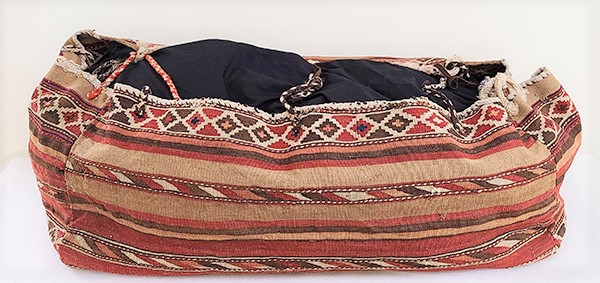Shahsevan Bedding Bag

This large woven bedding bag was made around the turn of the 20th century by the Shahsevan people in Northwest Iran (then Persia). The Shahsevan are traditionally nomadic pastoralists, traveling between their winter home in the steppe and summer lands at higher elevation near Mount Sabalan. During the last century, many Shahsevan gave up the nomadic life and settled into permanent homes.
Shahsevan bedding bags like this one are also known as mafrash, and they were used to hold quilts, blankets, and other bedding materials. Although they were made by other nomadic groups in eastern Turkey, Northwest Persia, and the Caucasus, the Shahsevan were the most prolific. The bags were often made in pairs to create a balanced load on the backs of camels while traveling. Because of their large size, they were previously misidentified by collectors as children’s cradles. Mafrash are the largest form in a category of woven bags used by nomadic people to carry a wide variety of everyday supplies on camelback or horseback. The bags are not just utilitarian, but also provide an outlet for artistic expression.
Among the Shahsevan and other nomadic groups of the area, women were the weavers. Starting with raw wool, they spun it into yarn, dyed the yarn with natural vegetable-based dyes, and wove on small portable looms. Mafrash are flat woven using a method known as soumak, or supplementary weft wrapping, which produces a thick and durable textile. The bags are made from five separate woven sections, four sides and the bottom, that are then sewn together to complete the bag.
This bedding bag is from the Nicholas Salgo Collection. Other objects from the Salgo Collection that have been featured for Artifact of the Month include an Uzbek camel cover and a Tibetan saddle rug.
